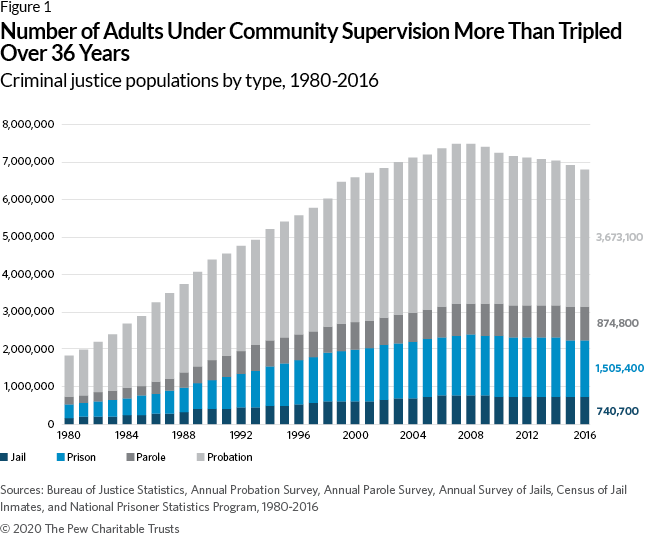How Are Probation And Parole Changing? What Does The Future Hold For Each?
Comprehensive Policies Tin can Improve Probation and Parole
Framework offers solutions to strengthen community supervision

Overview
The nation'southward community supervision population ballooned by nigh 240 per centum over the past 4 decades.1 In 2016, 1 in 55 U.Due south. adults (more than 4.5 million people) were on probation or parole, more than twice the share incarcerated in land and federal prisons and local jails.two (See Effigy 1.) Historically, probation and parole were intended to provide a less punitive, more than constructive culling to incarceration. Withal, a growing body of evidence suggests that a shift in emphasis toward surveillance and monitoring of people nether supervision, rather than promoting their success, and the growing resource demands of always-larger caseloads take transformed community supervision into a primary driver of incarceration.3 This has produced an array of troubling consequences, not only for individuals on probation and parole, merely also for taxpayers and communities.
To help address these problems, The Pew Charitable Trusts and Arnold Ventures convened an skilful advisory council to review bear witness on best practices and make recommendations on policies and practices that can help evangelize ameliorate outcomes for people nether supervision, their families, and communities; cut the number of people on probation and parole; and reduce technical revocations—a sanction for noncompliance with supervision rules—particularly those resulting in incarceration. The quango, fabricated upward of criminal justice experts and professionals from academia, the behavioral health field, community supervision, the courts, and law enforcement likewise as people who have been on supervision, developed a framework, organized effectually seven policy goals, that state leaders can use to align supervision systems with bear witness-based practices. Where the recommended policies are supported by research, the framework summarizes and cites that bear witness. This fact sheet offers a snapshot of the quango'due south recommendations.
Framework for a smaller, safer supervision organization
The advisory council organized its recommended policies according to the following objectives:
Enact alternatives to abort, incarceration, and supervision.
Enquiry has consistently shown that supervision is non constructive for individuals with a low risk of reoffending and can even increment that gamble.4 Additionally, probation and parole may be overly punitive for people who commit minor offenses. The council recommends using culling sanctions, including community service for people convicted of low-level offenses such as traffic violations and minor drug crimes.
Implement testify-based policies centered on risks and needs.
Show-based decision-making is the foundation of constructive supervision that yields positive outcomes, and its essential components are the principles of risk, demand, and responsivity (RNR)—an assessment methodology that enables parole and probation officers to develop case plans tailored to individuals' needs and level of gamble to reoffend. The quango recommends that agencies appraise people'southward risk and needs using validated tools and tailor example plans and supervision intensity based on those assessments.
Prefer shorter supervision sentences and focus on goals and incentives.
Two primary factors take driven growth in the customs corrections population: the number of people sentenced to probation and placed on parole and the length of time they spend nether supervision. Inquiry has demonstrated that long supervision terms evangelize diminishing public safety benefits.5 To address these challenges, agencies should prefer earned compliance credits and other incentives and policies that offering early termination of supervision for people who follow rules or meet other criteria.
Found constructive and appropriate supervision conditions.
People on supervision must follow a long list of standard conditions and sometimes special requirements too. Individuals who neglect to follow these rules can face sanctions, which can include incarceration.half dozen The council recommends locating officers and treatment programs virtually the people they serve to support compliance and limiting conditions to those that are well-nigh likely to enhance public safety and align with each person's case programme goals and assessed risks, such as by using drug testing simply when necessary to decide a handling need.
Develop individualized conditions for payment of legal financial obligations.
People are often ordered to pay fines, fees, and restitution as part of a criminal sentence. And many supervision agencies require the people they supervise to pay for drug testing, electronic monitoring, and other programs and conditions. Although these financial obligations can assist enforce accountability and mitigate victims' losses, they also impose economic burdens that tin can hinder supervision success.7 The council provided guidance to help agencies better manage the imposition and collection of fines and fees and recommended that states, agencies, and departments take steps to mitigate the harms associated with these costs to aid people successfully consummate supervision.
Reduce use of and pathways to incarceration.
Supervision revocations, especially for technical violations—noncompliance with 1 or more supervision rules that may upshot in a sanction—are a major commuter of costly incarceration, and even curt jail stays tin can cause people serious hardship, including loss of employment, decreased wages, housing insecurity, and family instability.viii The quango recommends limiting the use of arrest and incarceration as a sanction for technical violations and before revocation hearings and guaranteeing counsel in those hearings.
Meaningful and lasting reform will require upfront investments. States must ensure that agencies are equipped with the resources they demand to implement testify-based practices while supporting the work of probation and parole officers to enhance successful supervision completion.
Endnotes
- Agency of Justice Statistics, "Annual Probation Survey and Annual Parole Survey" (1980-2016), https://world wide web.bjs.gov/index.cfm?ty=pbdc&dcid=271&iid=1.
- D. Kaeble, "Probation and Parole in the Usa, 2016,"Bureau of Justice Statistics (April 2018), https://world wide web.bjs.gov/index.cfm?ty=pbdetail&iid=6188.
- M.P. Jacobson et al., "Less Is More: How Reducing Probation Populations Can Amend Outcomes" (2017), Harvard Kennedy Schoolhouse Program in Criminal Justice Policy and Management, https://www.hks.harvard.edu/sites/default/files/centers/wiener/programs/pcj/files/less_is_more_final.pdf.
- E.J. Latessa, L.B. Lovins, and P. Smith, "Final Written report: Follow-Upwardly Evaluation of Ohio'south Community Based Correctional Facility and Halfway House Programs—Outcome Study" (2010), https://www.uc.edu/content/dam/uc/ccjr/docs/reports/project_reports/2010%20ODRC%20HWH%20FINAL%20REPORT2.pdf; The Pew Charitable Trusts, "Risk/Needs Assessment 101: Science Reveals New Tools to Manage Offenders" (2011), http://world wide web.pewtrusts.org/~/media/legacy/uploadedfiles/pcs_assets/2011/pewriskassessmentbriefpdf.pdf; D.A. Andrews and J. Bonta, The Psychology of Criminal Conduct (New York: Routledge, 2010).
- Yard.D. Morgan, "Factors Associated With Probation Result," Journal of Criminal Justice 22, no. 4 (1994): 341-53, http://search.ebscohost.com/login.aspx?direct=true&db=edsrep&AN=edsrep.a.eee.jcjust.v22y1994i4p341.353&site=eds-alive&authtype=sso&custid=s3229936; D.E. Olson and Fifty.J. Stalans, "Fierce Offenders on Probation: Profile, Sentence and Outcome Differences Among Domestic Violence and Other Violent Probationers," Violence Against Women 7, no. 10 (2001): 1164-85, http://search.ebscohost.com/login.aspx?direct=true&db=edsbl&AN=RN103205566&site=eds-live&authtype=sso&custid=s3229936; B. Sims and Thousand. Jones, "Predicting Success or Failure on Probation: Factors Associated With Felony Probation Outcomes," Law-breaking & Delinquency 43, no. 3 (1997): 314-27, https://journals.sagepub.com/doi/10.1177/0011128797043003005.
- F.Due south. Taxman, "Probation, Intermediate Sanctions, and Community-Based Corrections," in The Oxford Handbook of Sentencing and Corrections, eds. J. Petersilia and K.R. Reitz (New York: Oxford Academy Press, 2012), https://www.oxfordhandbooks.com/view/10.1093/oxfordhb/9780199730148.001.0001/oxfordhb-9780199730148-e-15.
- R.B. Ruback, A.C. Cares, and S.North. Hoskins, "Crime Victims' Perceptions of Restitution: The Importance of Payment and Understanding," Violence and Victims 23, no. 6 (2008): 697-710, https://world wide web.ncbi.nlm.nih.gov/pubmed/19069562.
- D.J. Harding, J.A. Siegel, and J.D. Morenoff, "Custodial Parole Sanctions and Earnings Afterwards Release From Prison house," Social Forces 96, no. 2 (2017): 909-34, http://search.ebscohost.com/login.aspx?directly=truthful&db=a9h&AN=127291872&site=ehost-live&authtype=sso&custid=s3229936; C.M. Klingele, "Rethinking the Utilize of Community Supervision," Journal of Criminal Law & Criminology 103, no. 4 (2013): 1015-69, https://papers.ssrn.com/sol3/papers.cfm?abstract_id=2232078#.
ADDITIONAL Resources
More than FROM PEW
Source: https://www.pewtrusts.org/en/research-and-analysis/fact-sheets/2020/04/comprehensive-policies-can-improve-probation-and-parole
Posted by: huppforgerbours.blogspot.com



0 Response to "How Are Probation And Parole Changing? What Does The Future Hold For Each?"
Post a Comment